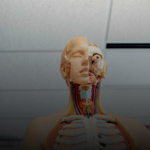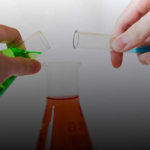Section 1
Preview this deck
Third Degree Burn
Front
Active users
0
All-time users
0
Favorites
0
Last updated
5 years ago
Date created
Mar 1, 2020
Cards (64)
Section 1
(50 cards)
Third Degree Burn
full thickness burn destroys epidermis, dermis, and the epidermal derivitaves burned area appears blanched (gray-white) or blackened with very little if any edema area around the burn shows symptoms of lesser degree burns
Second Degree Burn
burn that damages deep epidermis and upper dermis shows same symptoms as first degree burn but produces bullae (water filled blisters)
Stratum Corneum
layer of 25 to 30 rows of flat, dead, keratinized cells this layer flakes off
Dermis
thicker connective tissue layer tough but flexible loose connective tissue layer composed of a gel-like matrix heavily embedded with collagen, elastin, and reticilin fibers
Platelet (Thrombocyte)
formed element of the blood which contains an enzyme for clotting known as thromboplastin
Eponychium (Cuticle)
narrow band of epidermis that occupies the proximal border of the nail and consists of stratum corneum
End bulbs of Krause
dermal cold receptors
Hair Structure
Shaft - superficial portion which projects above the skin surface which has three principle parts (medulla - inner region, cortex - middle layer, and cuticle - outer layer) Root - hair below the dermis and subcutaneous layer Bulb - enlarged base of the hair containing an indentation called the papilla and contains the matrix (germinal layer or growth region of the hair)
Third Stage of the Inflammatory Response
3. Release of nutrients - nutrients are needed to fight antigens and repair damage
Granulation
new cells originate from cells of the stroma and parenchymal cells from the functioning parts of the tissue or organ
Fifth Stage of the Inflammatory Response
Pus formation - thick fluid containing living and non-living white cells plus debris from dead and damaged tissue accumulates (abscess or ulcer)
Keratinocytes
produce keratohaline (eventually keratin)
Fibrosis
formation of scar tissue
Step 5 of Blood Clotting
5. syneresis occurs syneresis is clot retraction and shrinkage which serves to bring the edges of torn tissue together
Stratum Germinativium
what the stratum basale and stratum spinosum are usually called together
Nails
modified horny cells of the epidermis nail consists of a nail body, free edge, and the nail root most of the nail body is pink due to the underlying vascular tissue except for the whitish semilunar area at the proximal end known as the lunula
First Degree Burn
burn that damages only the epidermis symptoms are localized redness, edema, and pain
First Stage of the Inflammatory Response
1. Vasodilation and increased permeability of blood vessels - produces heat, redness, and swelling (edema) - caused by the release of histamines primarily from mast cells, and some from basophils and platelets - kinins from the blood plasma increases the permeability of the vessels and attracts neutrophils - stage allows the clotting elements into the injured area
Fourth Stage of the Inflammatory Response
4. Fibrin formation - fibrinogen precipitates out as fibrin (protein fibers) which localizes and traps invading organisms and debris - eventually forms fibrin clot that prevents hemorrhage and isolates the infected area
Step 6 of Blood Clotting
6. fibrinolysis - the dissolving away of the old clot and some scar tissue
Root Hair Plexus
nerve net around the hair follicle for tactile sense of the hair especially in vibrissae
Hair
Lanugo (fetal hair) - usually shed prior to birth except in the regions of the eyebrows, eye lashes, and scalp Vellus (fleece) - facial and body hair Terminal Hairs - coarse hair of scalp, eyebrows, and pubic hair
Plasma Inclusions
vitamin K - coenzyme for blood clotting by initiating the synthesis of prothrombin calcium ions - Ca+ ions are involved in all stages of blood clotting while removal or binding of Ca+ prevents clotting
Papillary Layer
upper thin layer which forms the dermal papillae which protrude into the lower region of the dermis containing capillary loops results in the friction ridges on our fingers known as finger prints
Sudoriferous or Sweat Glands
simple, coiled, tubular glands produce perspiration which is a mixture of water, salts, urea, uric and amino acids, ammonia, sugar, lactic acid, and other wastes aids in secretion of waste products and regulating body temperature
Stratum Basale
single layer of columnar cells capable of mitosis which produces new skin cells (germinal layer)
Stratum Spinosum
8 to 10 rows of polyhedral cells with spine-like projections, sometimes called Prickle cells
Step 2 of Blood Clotting
2. thromboplastin activates prothrombin which then becomes thrombin
Step 4 of Blood Clotting
4. fibrin fibers stick together and form a fibrin net which forms fibrin/blood cell clot
Epidermis
epithelial layer
Second Stage of the Inflammatory Response
2. Phagocytic migration - white cells (leukocytes) known as neutrophils and monocytes migrate to the injured area in response to the kinins - monocytes become phagocytic macrophages
Pacinian Corpuscle
deep pressure or crude touch receptors of the dermis
Stretch Marks
silvery white scars call striae caused by rapid growth causing a tearing in the dermis and in some pregnancies
Skin (Cutis)
largest organ of the body thickest on the dorsal and extensor surfaces and thinner on the ventral and flexor surfaces
Step 3 of Blood Clotting
3. thrombin reacts with the soluble fibrinogen causing the formation of fibrin fibers
Sebaceous or Oil Glands
simple, branched acinar or alveolar gland secrete sebum (oil) which is a mixture of fats, cholesterol, proteins, and inorganic salts keeps our skin and hair from drying out and aids in "water proofing" infections may cause oil build up which leads to blackheads and pimples
Step 1 of Blood Clotting
1. platelets come in contact with collagen fibers in injured area and rupture releasing thromboplastin
Meissner's Corpuscle
"fine touch" receptor (not as sensitive as Merkel's discs) located within the papillary region of the dermis
Nail Matrix
epithelium of the proximal part of the nail bed which is the growth region of the nail
Stratum Lucidum
translucent layer containing a translucent material called eleiden (not present in hairy skin)
Reticular Layer
typical dense irregular connective tissue that contains bundles of interlocking collagen fibers that run in various planes parallel to the skin forming lines of cleavage, tension lines, and flexure lines
Stratum Granulosum
2-3 layers of flattened cells where keratinization occurs due to the accumulation of keratohaline
Free Nerve Endings
sensory for pain located within the dermis
Blood Clotting
coagulation of the blood may be extrinsic or intrinsic
Plasma Proteins
soluble fibrinogen - soluble protein produced by the liver which becomes fibrin during blood clotting prothrombin (inactivated thrombin) - soluble protein produced by the liver
Nail Fold
fold of skin beneath the nail bed and the furrow between the two is the nail groove
What are the functions of skin?
The skin functions to protect, maintain body temperature, pick up stimuli, synthesize Vit. D, excrete wastes, keep the body from losing water, and hold the body together.
Merkel's Discs
most sensitive of the "fine touch" receptors of the skin only receptor located in the stratum germinativium of the epidermis
Hyponichium
thickened area of stratum corneum below the free edge of the nail
Melanocytes
produce skin pigments like melanin
Section 2
(14 cards)




